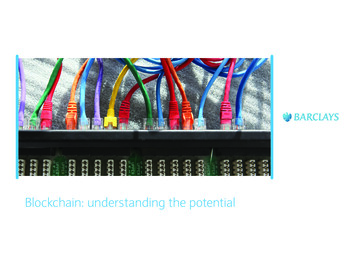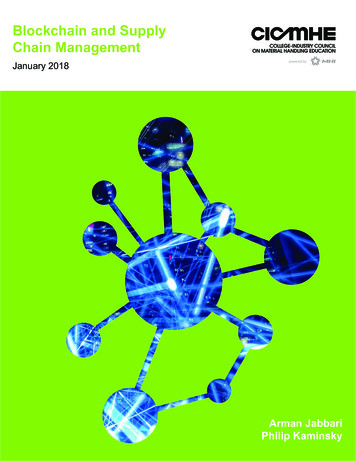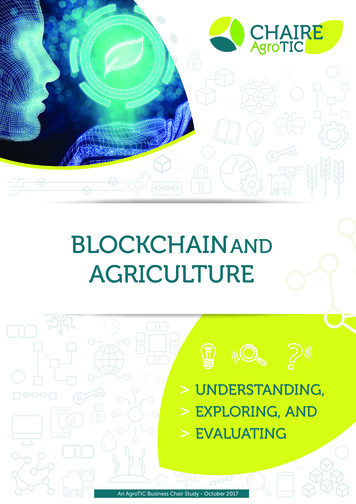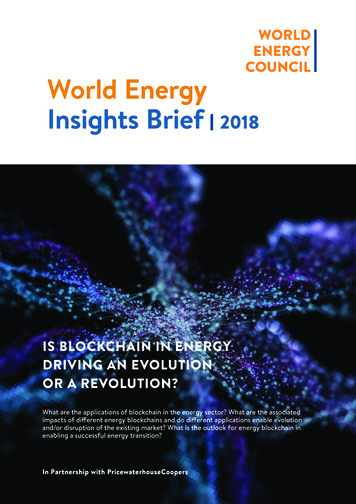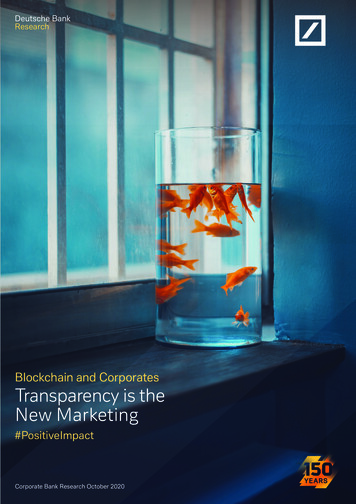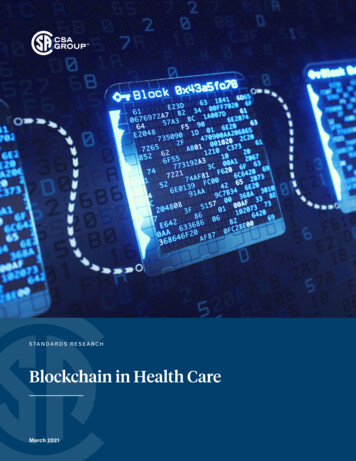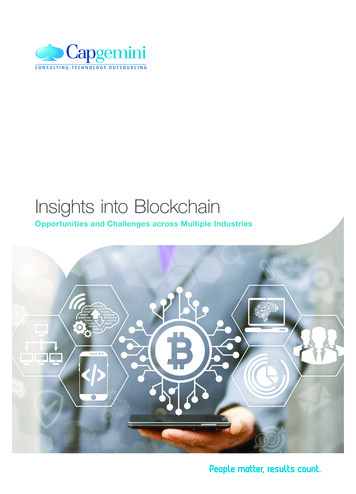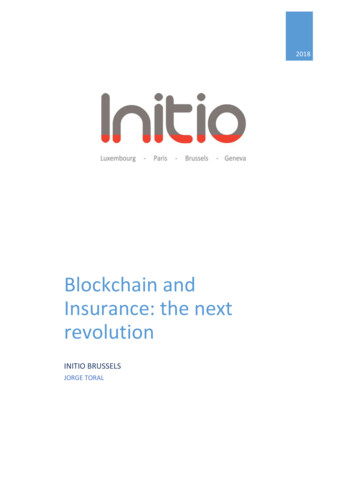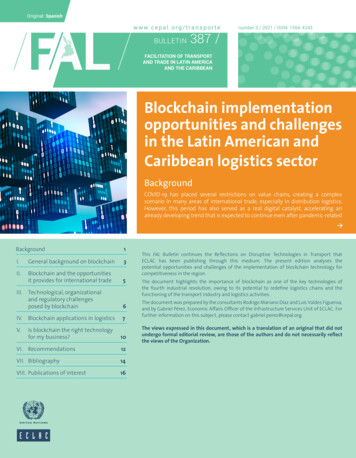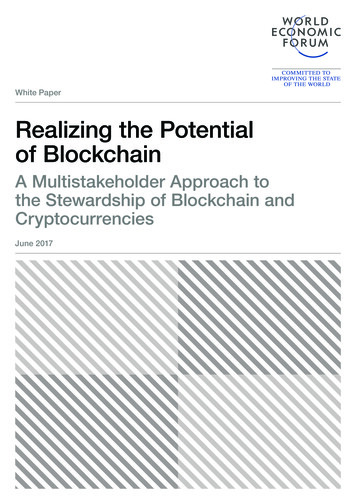
Transcription
White PaperRealizing the Potentialof BlockchainA Multistakeholder Approach tothe Stewardship of Blockchain andCryptocurrenciesJune 2017
White Paper Authors:Don Tapscott and Alex TapscottContentsPreface 2Executive Summary 3The Blockchain as a New Global Resource 4New Thinking in How to Steward a Global Resource: The Internet as a Case Study5Blockchain Governance Challenges71. Stewardship of platforms 102. Stewardship of applications 243. Stewardship of the ecosystem as a whole27The Players in the Blockchain Ecosystem32The “Global Solution Networks” (GSN) Framework Applied to Blockchain34Standards networks: Don’t deify differences; codify common ground36Networked institutions: Welcome stakeholders everywhere37Advocacy networks: Respect members’ interests and constraints38Watchdog networks: Do no harm 38Policy networks: Participate in debate and coordinate regulation39Knowledge networks: Know what you don’t know40Delivery networks: Keep incentives for mass collaboration in mind41Summary: What Needs to Be Done 42About the Authors 45Appendix: Global Solution Networks 46Knowledge networks 46Operational and delivery networks 48Policy networks 49Advocacy networks 49Standards networks 50Networked institutions 51Acknowledgements 51Notice 51Endnotes 53World Economic Forum91-93 route de la CapiteCH-1223 Cologny/GenevaSwitzerlandTel.: 41 (0)22 869 1212Fax: 41 (0)22 786 2744Email: contact@weforum.orgwww.weforum.orgWorld Economic Forum 2017 – All rights reserved.No part of this publication may be reproduced ortransmitted in any form or by any means, includingphotocopying and recording, or by any informationstorage and retrieval system.REF 240617 — 00034436The views expressed in this White Paper are those of the author(s) and do notnecessarily represent the views of the World Economic Forum or its Membersand Partners. White Papers are submitted to the World Economic Forum ascontributions to its insight areas and interactions, and the Forum makes the finaldecision on the publication of the White Paper. White Papers describe researchin progress by the author(s) and are published to elicit comments and furtherdebate.
PrefaceDistributed ledger technology promises to have far-reaching economic and social implications. Byleveraging a global peer network to assure directly and transparently the integrity of value exchangedbetween parties, blockchain appears likely to transform a number of important industries thatsupply or rely upon third-party assurance. It could prove to be a broader force for transparency andintegrity in society, including in the fight against bribery and corruption. It could also lead to extensivechanges in supply chains and governmental functions, such as central banking.The extent to which this new technology realizes its potential will depend in substantial part uponhow well stakeholders steward its development. There remain important open governance questionsregarding both the functioning of the technology and its current and potential applications.The World Economic Forum and its new Center for the Fourth Industrial Revolution is pleasedto publish this foundational survey of blockchain governance challenges and multistakeholdercooperation opportunities. Authored by Don and Alex Tapscott, leading experts on both blockchainand multistakeholder governance, this White Paper provides a structured analytical frameworkand taxonomy for use by industry, technical, governmental, civil society and other stakeholders inconsidering how they might collaborate to resolve problems and unlock opportunities beyond thereach of any single actor.As Don and Alex emphasize, a distributed ecosystem need not be a disorganized one, and improvedgovernance need not imply formal governmental legislation or regulation. A cooperative process ofmultistakeholder dialogue and stewardship can go a long way in improving trust and helping newtechnological systems develop in a socially beneficial manner.This is the animating purpose of the Center for the Fourth Industrial Revolution: to provide aninternational platform for public-private dialogue and cooperation in respect of the stewardshipand agile governance of new technologies. We thank the authors for their contribution, which webelieve provides a solid foundation for precisely such a process in respect of blockchain. We alsothank members of the World Economic Forum Global Future Council on the Future of Blockchainand others who provided feedback on the White Paper, which expresses the perspectives of theauthors alone and not necessarily those of the Forum as an institution or its individual Members andconstituents.Richard SamansHead of the Center for the Global Agenda and Member of the Managing BoardZvika KriegerHead of Technology Policy and PartnershipsGeneva and San Francisco, June 2017Realizing the Potential of Blockchain3
Executive SummaryLike the first generation of the internet, this second generation promises to disrupt business modelsand transform industries. Blockchain (also called distributed ledger), the technology enablingcryptocurrencies like bitcoin and Ethereum, is pulling us into a new era of openness, decentralizationand global inclusion. It leverages the resources of a global peer-to-peer network to ensure theintegrity of the value exchanged among billions of devices without going through a trusted thirdparty. Unlike the internet alone, blockchains are distributed, not centralized; open, not hidden;inclusive, not exclusive; immutable, not alterable; and secure. Blockchain gives us unprecedentedcapabilities to create and trade value in society. As the foundational platform of the Fourth IndustrialRevolution,1 it enables such innovations as artificial intelligence (AI), machine learning, the internet ofthings (IoT), robotics and even technology in our bodies, so that more people can participate in theeconomy, create wealth and improve the state of the world.However, this extraordinary technology may be stalled, sidetracked, captured or otherwisesuboptimized depending on how all the stakeholders behave in stewarding this set of resources –i.e. how it is governed.Like the first era of the internet, this blockchain era should not be governed by nation states, statebased institutions or corporations. How we govern the internet of information as a global resourceserves as a model for how to govern this new resource: through a multistakeholder approach usingwhat we call “global governance networks”– a concept developed in our previous multimillion-dollarprogramme investigating multistakeholder networks for global problem-solving.2 We discuss seventypes of networks: standards networks, such as the Internet Engineering Task Force; knowledgenetworks, such as the Internet Research Task Force; delivery networks, such as the InternationalCorporation for Assigned Names and Numbers; policy networks, such as the Internet PolicyResearch Initiative at the Massachusetts Institute of Technology (MIT); advocacy networks, such asthe Alliance for Affordable Internet; watchdog networks, such as the Electronic Freedom Forum; andnetworked institutions, such as the World Economic Forum.We explain the core differences between the internet of information as a network of similar networksand the blockchain as a balkanized internet of value, where real assets are at stake. Then we coverwhat we have found to be the most urgent threats to this resource, which we view as governancechallenges. By governance, we mean stewardship, which involves collaborating, identifying commoninterests and creating incentives to act on them. We do not mean government, regulation or topdown control. We explore governance needs at three levels: platform, application and the ecosystemas a whole.Unlike the internet of information, which is a vast network of similar networks, this internetof value requires stewardship at not just one level but three. At the platform level, we look atbitcoin’s scalability issue and energy consumption, Ethereum’s switch to proof-of-stake and crisismanagement by consensus, and Hyperledger’s call for both urgency and moderation aroundstandards. At the application level, we look at the need for oversight, skilled talent and user-friendlyinterfaces. At the overall ecosystem level, we look at the need for a proper legal structure, regulatoryrestraint, diversity of viewpoints and scientific research in tandem with business development. Weintroduce each of the eight stakeholders in the ecosystem: innovators, venture capitalists, banks andfinancial services, developers, academics, non-governmental organizations (NGOs), governmentbodies, and users or citizens.We apply our previously developed “global solution networks”3 (GSN) framework to blockchaingovernance. We urge stakeholders in the space to codify their common ground through standardsnetworks; welcome stakeholders with radically diverse views of what needs to be done throughnetworked institutions; respect members’ interests and constraints through advocacy networks;ensure that no one does any harm through watchdog networks; participate in policy debates andcoordinate regulation through policy networks; get up to speed through knowledge networks; andkeep incentives for mass collaboration in mind through delivery networks. Finally, we outline themost pressing governance work to be done, if we are to preserve and steward this new globalresource to achieve its vast potential.4Realizing the Potential of Blockchain
The Blockchain as aNew Global ResourceThe internet is entering a second era that’s based onblockchain. The last few decades brought us the internet ofinformation. We are now witnessing the rise of the internetof value. Where the first era was sparked by a convergenceof computing and communications technologies, thissecond era will be powered by a clever combination ofcryptography, mathematics, software engineering andbehavioural economics. It is blockchain technology, alsocalled distributed ledger technology. Like the internetbefore it, the blockchain promises to upend businessmodels and disrupt industries. It is pushing us to challengehow we have structured society, defined value andrewarded participation.Blockchain emerged in the wake of the global economiccrisis, when a pseudonymous person or persons namedSatoshi Nakamoto released a new protocol for “A Peerto-Peer Electronic Cash System” using a cryptocurrencycalled bitcoin.4 Cryptocurrencies (digital currencies)are different from traditional fiat currencies because nogovernment issues or controls them. They’re not savedin a file somewhere; they’re represented by transactionsrecorded in a blockchain – like a global spreadsheet orledger, which leverages the resources of a large peer-topeer bitcoin network to verify and approve each bitcointransaction. Satoshi’s protocol established a set of rules –in the form of distributed computations – that ensured theintegrity of the data exchanged among billions of deviceswithout going through a trusted third party. This newresource has six critical qualities.Each blockchain, like the one that uses bitcoin, isdistributed: it runs on computers provided by volunteersaround the world; there is no central database to hackor shut down. We can send money and soon any formof digitized value – from stocks and bonds to intellectualproperty, art, music and even votes – directly and safelybetween us without going through a bank, a credit-cardcompany, PayPal or Western Union, social network,government or other middleman. Of course, this does notmean that middlemen will disappear. Rather the technologyprovides profound opportunities for innovative companiesand institutions in the middle to streamline processes,increase their metabolism, create new value and enter newmarkets.Blockchain is encrypted: it uses heavy-duty encryptioninvolving public and private keys (rather like the two-keysystem to access a safety deposit box) to maintain virtualsecurity. We needn’t worry about the weak firewalls of theUS Democratic National Party, a thieving staffer of MorganStanley or a perversely incentivized employee of WellsFargo.In many cases, blockchain is public: anyone can view it atany time because it resides on the network, not within asingle institution charged with auditing transactions andkeeping records. No one can hide a transaction, and thatmakes bitcoin more traceable than cash. It is open-sourcecode: anyone can download it for free, run it and use it todevelop new tools for managing transactions online. Privateblockchains have emerged that don’t use cryptocurrencyfor consensus.Blockchain is, for the most part, inclusive. Satoshi imaginedthat the typical person would be interacting with theblockchain through what he called “simplified paymentverification” mode that can work on a mobile device.5Now anyone with a flip phone can participate in the globaleconomy; no documentation is required to be trusted.Blockchain is immutable. Within minutes or even seconds,all the transactions conducted are verified, cleared andstored in a block that is linked to the preceding block,thereby creating a chain. Each block must refer to thepreceding block to be valid. This structure permanentlytimestamps and stores exchanges of value, preventinganyone from altering the ledger.Blockchain is historical. If we wanted to steal a bitcoin,we’d have to rewrite a coin’s or asset’s entire history onthe blockchain in broad daylight. So the blockchain is adistributed ledger representing a network consensus ofevery transaction that has ever occurred. Therefore, wemust preserve the blockchain in its entirety. That’s whystorage matters.This is much more than the financial services industry.Innovators are programming this new digital ledgerto record anything of value to humankind – birth anddeath certificates, marriage licenses, deeds and titlesof ownership, rights to intellectual property, educationaldegrees, financial accounts, medical history, insuranceclaims, citizenship and voting privileges, location ofportable assets, provenance of food and diamonds, jobrecommendations and performance ratings, charitabledonations tied to specific outcomes, employmentcontracts, managerial decision rights and anything elsethat we can express in code.So important is this new resource that some have calledthe blockchain a public utility like the internet, a utility thatrequires public support. Paul Brody, principal and globalinnovation leader of blockchain technology at Ernst &Young, thinks that all our appliances should donate theirprocessing power to the upkeep of a blockchain: “Thanksto the smartphone business driving very low-cost systems,your lawnmower or dishwasher is going to come with aCPU that is probably a thousand times more powerful thanit actually needs, so why not have the appliance mine?Not to make money, but to contribute to the security andviability of the blockchain as a whole,” he said.6Realizing the Potential of Blockchain5
We’ve never had this capability before – trustedtransactions directly between two or more total strangers,authenticated by mass collaboration, and powered bycollective self-interests, rather than by corporationsmotivated by profit or governments motivated by power.It is the culmination of what Alan Turning started, atrue paradigm shift ushered in by decentralized ledgertechnologies.In this report, our goal is not to provide specific proposals,though we have suggested a few possible directions. Ourgoal is to describe the landscape, provide a taxonomy forrich discussions, map the diverse players to the taxonomy,surface the topics of concern and identify the requirementsfor better stewardship. We encourage all players – notjust those in financial services – to think about wholeecosystem and not simply their own narrow interests. Webelieve that this rising tide should lift all boats.New Thinking in Howto Steward a GlobalResource: The Internetas a Case StudyThe governance of critical global resources – water, oldgrowth forests, fisheries and the internet itself – has beena key focus of our research over the last five years. Whenwe use the word, governance, we mean stewardship,which involves collaborating, identifying common interestsand creating incentives to act on them. We do not meangovernment, which involves legislating and regulatingbehaviour and punishing those who misbehave.Since the end of World War II, state-based institutions haveadministered most of the world’s important resources. Twoof the most powerful – the International Monetary Fundand the World Bank – were born at the Bretton WoodsConference in 1944. The United Nations and other groupsunder its umbrella – the World Health Organization andthe World Trade Organization – received a wide berthto exercise their monopoly on global problem-solving.These organizations were hierarchical by design, becausehierarchies were the dominant paradigm during the firsthalf of a war-torn century.But while necessary, these industrial-scale solutions wereand still are insufficient for the challenges of the digital era.The rise of the internet marked a significant departure fromthe traditional culture of governance. “We reject kings,presidents and voting,” said MIT computer scientist DavidClark in 1992. “We believe in rough consensus and runningcode.”7 That was the mantra for stewardship of the firstgeneration of the internet when few could imagine how itwould transform human existence. Clark’s words embodieda philosophy for the leadership of a global resource thatwas radically different from the Bretton Woods model, yetone that engendered a remarkably effective governanceecosystem. That the internet has become a global resourcein so short a time is astounding, in no small part thanksto strong leadership and governance and despite thepowerful forces against it.Governance means stewardship, not government orregulation.In our 2013-2015 research, we set out to do the definitiveinvestigation into internet governance – who exactly wasproviding this stewardship to ensure the developmentand continuance of the internet and what made theecosystem tick. No government or group of governmentscontrols the internet or its standards, though several U.Sgovernment agencies once funded it.8 Instead, a vastecosystem of companies, civil society organizations,software developers, academics and state-based6Realizing the Potential of Blockchain
institutions were collaborating in transparent, distributedforums that defied measurement by traditional commandand-control frameworks. In the infancy of the internet asa global resource, this ecosystem has proven that diversestakeholders, loosely organized in seven types of opennetworks that operate by consensus, could effectivelysteward a global resource.1. Standards networksStandards networks are non-state, non-profit organizations– such as the Internet Architecture Board (IAB) and theInternet Engineering Task Force (IETF) – that developtechnical specifications and standards, the building blocksof the product, and infrastructure development that leadsto mass adoption. To succeed as standards networks, theIAB and IETF regularly engage the expertise of individuals,civil society organizations and private-sector enterprise.Similarly, the World Wide Web Consortium (W3C) develops,tests and implements standards that promote the web’sevolution and ensure its interoperability.2. Knowledge networksThe primary function of knowledge networks is to conductresearch and develop new ideas that can help solve globalproblems. For example, the Internet Research Task Force(IRTF) investigates emerging technologies of potentialrelevance to the internet. If IRTF creates a specificationsuitable for standardization, then it proposes it to the IETF.More savvy users can realize the upside of new globalresources while minimizing the downside. Internet2 (www.Internet2.edu) is a global research and education networkdesigned to remove barriers to discovering new knowledgeand its impact.3. Delivery networksThis class of networks actually delivers the change it seeks,supplementing or even bypassing the efforts of traditionalinstitutions. For example, the International Corporation forAssigned Names and Numbers (ICANN) delivers domainnames. Supporting delivery networks include AfricanNetwork Information Centre (AfriNIC), American Registry forInternet Numbers (ARIN), Asia-Pacific Network InformationCentre (APNIC), Latin America and Caribbean NetworkInformation Centre (LACNIC), and Réseaux IP EuropéensNetwork Coordination Centre (RIPE).4. Policy networksThese networks support policy development or seekalternatives for policy, whether governments support themor not. The goal is to inform, if not shape, the policy-makingprocess of corporations and governments so that it is moretransparent, shared and inclusive. For example, Internet& Jurisdiction facilitates transnational cooperation oncybersecurity, human rights, and other legal and economicpolicies.9 The Internet Policy Research Initiative at theMIT Computer Science and Artificial Intelligence Lab alsoworks with technologists and policy-makers to increasethe integrity of interconnected digital systems. In 2016, 17public interest groups collaborated to develop the InternetPolicy Platform, which featured specific policy initiativeson internet access, choice, free speech, privacy andtransparency.105. Advocacy networksAdvocacy networks seek to change the agenda or policiesof governments, corporations and other institutions.Among them are internet.org and the Alliance forAffordable Internet, which advocate for greater inclusion.The Industrial Internet Consortium, a relatively new opengroup of researchers, companies and public agencies, isadvocating the adoption of internet applications acrossvarious industries to accelerate the IoT.116. Watchdog networksThese networks scrutinize organizations to ensure that theybehave appropriately. Topics range from human rights,corruption and the environment, to financial services andcommercial practices. In the process, they drive publicdebate, boost transparency and ignite movements forchange. Perhaps the most vocal watchdog of civil libertiesonline is the Electronic Frontier Foundation.12 It scrutinizescorporate and government policies and holds themaccountable through litigation and grass-roots activism.7. Networked institutionsSome networks provide such a wide range of capabilitiesthat we describe them as “networked institutions”. Theyare not state-based but true multistakeholder networks.The value they generate can range from knowledge,advocacy and policy to the actual delivery of solutions. TheInternet Society, for example, excels at incorporating themany views of diverse stakeholders, not just the efforts ofthe IAB, the IETF and the IRTF, but also the InternationalTelecommunications Union, the Organisation for EconomicCo-operation and Development, the World IntellectualProperty Organization and several other United Nationscommissions.13The Internet Governance Forum (IGF) alsoengages participation across stakeholder groups.Most governments showed both restraint and foresight inregulating the internet.In the early days of the internet, governmentsdemonstrated both restraint and foresight. They showedrestraint by limiting regulation and control throughoutthe internet’s evolution and they showed foresight byallowing the system to flourish before trying to imposerules and regulations. Now that the internet has permeatedevery aspect of our lives, courts and legislators havestarted recognizing new claims, such as the right to beforgotten, and imposing local rules that often conflict in theglobal realm of the digital. As the best example of a truenetworked institution (not controlled by nation states), theWorld Economic Forum has stepped up to caution againstsuch uncoordinated legal efforts that only fragment theinternet, creating what some are calling the “splinternet”,and thereby stunting the “internet’s enormous capacity tofacilitate human progress”.14Realizing the Potential of Blockchain7
Blockchain GovernanceChallengespermissionless blockchain is that no one has the right toanything. There are really just powers, what you have thepower to do, what you can do. Joichi Ito put it in theseterms: “You can regulate networks, you can regulateoperations, but you can’t regulate software.”17 On theinternet of value, people will have the power to expressthemselves and the power to preserve their expressionwithout restriction.In our previous research, we determined that thestewardship of the internet of information was relativelysimple compared to what this nascent internet of valuewould need. True, the internet has been a vast “networkof networks” with intricate issues of standards and othergovernance challenges. But we all use basically the samecoherent platform globally. On it rests the world wide weband countless other applications.But these differences don’t require government to control,oversee or somehow govern the blockchain revolution. Thegenius of distributed ledgers is that the technology (andeverything that happens with it) is and must be distributed.Power is distributed. Heavy-handed governmentintervention would kill this embryonic technology in its egg.Blockchain, at least at this stage of its development, ismore balkanized and complex. The economic stakesare higher. “This is very different from the somewhathippy style that the open-source, free software internetmovement had,” Joichi Ito, Director of the MIT Media Labsaid. “We’re going a little too fast in promising our investorsa functioning infrastructure. Many companies are raisingmoney as if they’re ready for production. . These guys areall under the microscope, under the gun. Many of them areheavily funded and it’s really hard.”15The internet is a network of similar networks.The blockchain is a ledger of different and sometimescompeting ledgers.“Bitcoin is a car going down the road at 1,000 mph,” saidMatthew Roszak, Co-Founder of Bloq Inc. “Developers arenot the drivers of this car, yet they are tasked with repairingand upgrading this car without turning it off, stopping itor rebooting it.”16 Most developers prefer it that way. Theythink bitcoin is already very well regulated by mathematics,which are not up to the whims of governments. Otherdevelopers take issue with the word, governance, becausethey associate it with the belief that the technology isbroken and needs to be fixed or that the process hasstopped working and needs to be saved. They prefer theword, stewardship – and appropriately so.Where the internet democratized information, theblockchain democratizes value and cuts to the coreof legacy industries like banking. It also pertains to themanagement of money, wealth, intellectual property andother forms of value for which many societies expectgovernment to protect the public interest. So we all needto acknowledge that, while governments and regulatorsalone lack the knowledge, resources and mandate togovern this technology effectively, government participationand even regulation will likely have a greater influence overblockchain technologies to ensure that we preserve boththe rights and powers of consumers and citizens.People in free societies have the right to free speech andhave the power to express it on the internet of informationbut not the power to protect it from piracy, hacking orcensorship. One of the defining characteristics of an open8Realizing the Potential of BlockchainRather, we need self-organizing, bottom-up andmultistakeholder governance. In fact, this type ofgovernance is the best protection from governmentinterference and subjugation. According to PrimaveraDe Filippi, faculty associate at the Berkman Center forInternet & Society at Harvard and a permanent researcherat the National Center of Scientific Research in Paris, theabsence of a formalized governance structure has twopossible effects: either blockchain-based communitieshave difficulty acting or reacting expeditiously or elseinformal and invisible power dynamics emerge, often morecentralized than they appear.18 That bears repeating:without governance, invisible powers could emerge.In our research, we found ourselves exploring three levelsof blockchain that warrant stewardship (see Figure 1). Thefirst is the platform level, the protocols of blockchains suchas bitcoin, Ethereum, Ripple or Hyperledger. While peopleoften speak of virtual currency as a financial instrumentand blockchain as a payment system – and, therefore,relevant narrowly to banking and finance – we think ofthem more broadly as an ownership claim on a particulartechnology platform, a claim represented by a token thatcomes with decision rights and usually an incentive toensure the platform’s long-term success. So what wediscuss throughout this report applies to all domains, notjust finance.
Figure 1: Blockchain: Three Levels of GovernanceSource: AuthorsThe second is the application level, the tools that run onplatforms, tools such as smart contracts, that requiremassive cooperation between stakeholders to work.As with the internet, entrepreneurs have been quick toseize blockchain business opportunities and innovatebusiness practices. The recent rise of so-called “initialcoin offerings” is turbocharging growth at the applicationlayer, raising regulatory questions and accelerating theneed for multistakeholder governance. With the internetof information, various companies, governments, NGOsand individuals could simply build an application usingeither the web or more proprietary mobile platforms likethe iPhone or Android. However, because blockchain is allabout value, developers are building applications, networksand projects within particular ecosystems – sometimeswith a complex assembly of stakeholders who create,exchange and manage value.Consider the Belt and Road project – the new Silk Roadra
Jun 17, 2017 · Realizing the Potential of Blockchain 5 The Blockchain as a New Global Resource The internet is entering a second era that’s based on blockchain. The last few decades brought us the internet of information. We are now witnessing the rise of the internet o
